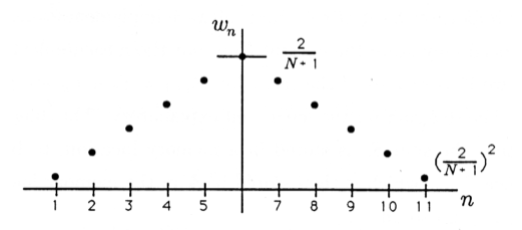6.3: Weighted Averages
- Page ID
- 9984
Weighted, tapered, or windowed averages are straightforward generalizations of simple averages. They take the form
\[x=\sum_{n=1}^{N} w_{n} u_{n} \nonumber \]
with the constraint that the “weights in the window,” \(w_n\), sum to 1:
\[\sum_{n=1}^{N} w_{n}=1 \nonumber \]
When \(w_{n}=\frac{1}{N}\) then \(x\) is the simple average studied in the section on "Simple Averages".
There are many windows that are commonly used in engineering practice. For \(N\) odd, the standard triangular window is
\[w_{n}=\frac{2}{N+1}(1-\frac{2}{N+1}\Bigg |\frac{N+1}{2}-n|) \nonumber \]
This window, illustrated in Figure 1, weights the input \(u_{(N+1) / 2}\) by \(\dfrac{2}{N+1}\) and the inputs \(u_1\) and \(u_N\) by \(\left(\dfrac{2}{N+1}\right)^{2}\). The most general triangular window takes the form
\[w_{n}=\alpha(1-\beta|\frac{N+1}{2}-n|) ; \alpha, \beta>0, \quad N \text { odd. } \nonumber \]

Determine the constraints on \(\alpha\) and \(\beta\) to make the general triangular window a valid window (i.e., \(\sum_{n=1}^{N} w_{n}=1\)). Show that \(\alpha=\frac{2}{N+1}=\beta\) is a valid solution. Propose another solution that you like.
You are taking three 3-credit courses, one 5-credit course, and one 2-credit course. Write down the weighted average for computing your GPA in a system that awards 4.0 points for an A, 3.0 points for a B,..., and (horrors!) 0 points for an F.


